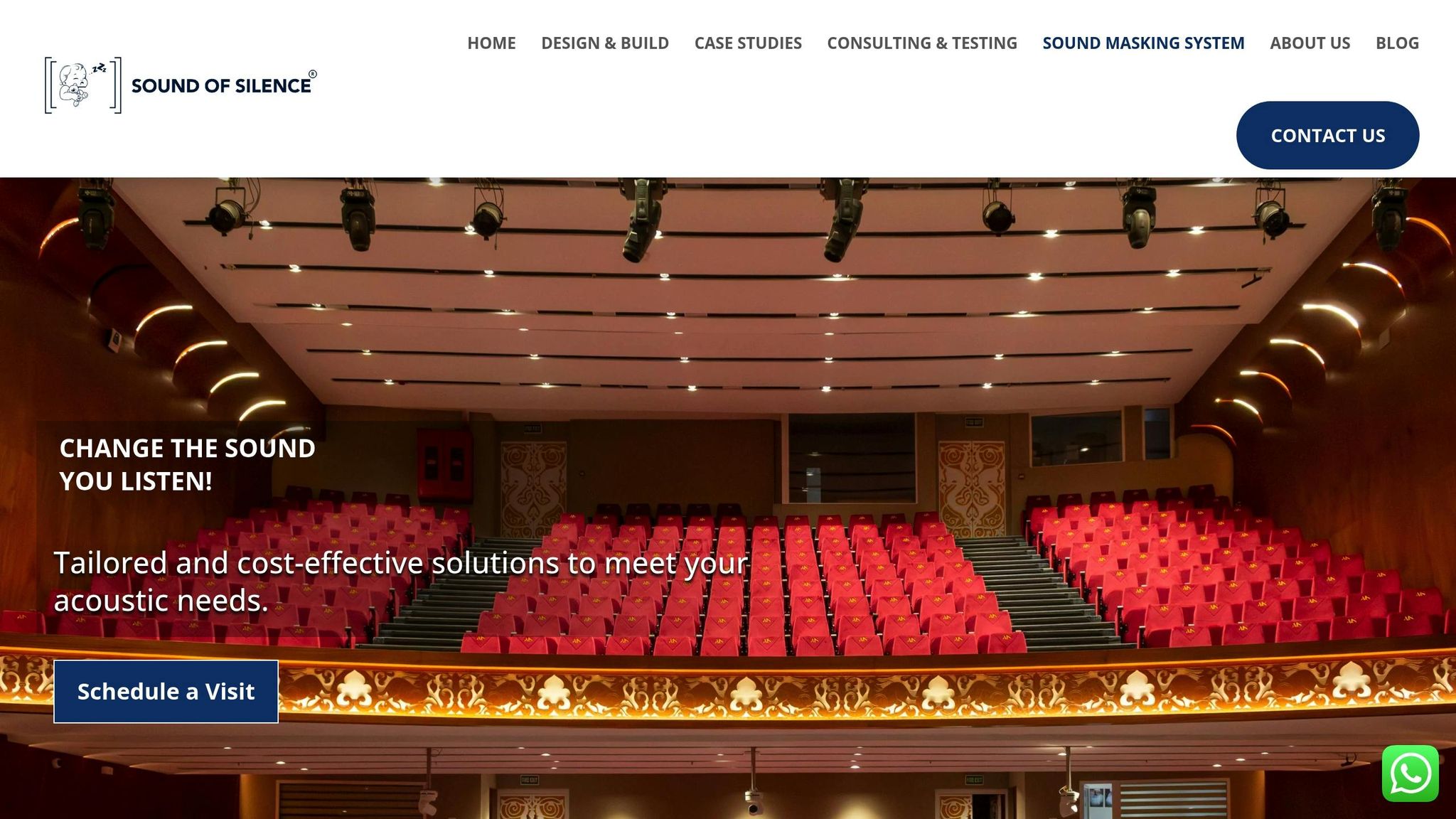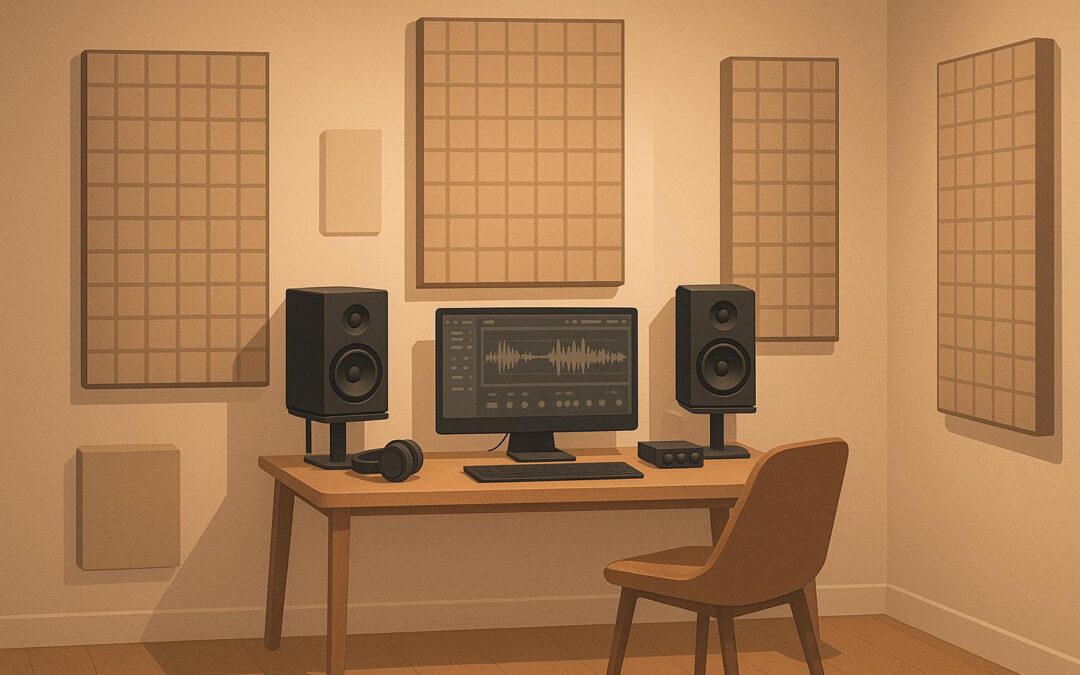First reflection points are where sound waves from speakers first hit surfaces like walls, ceilings, or floors before reaching your ears. These reflections can distort sound clarity, stereo imaging, and overall audio quality. Treating these areas improves sound balance, making your space ideal for listening or recording.
Key Takeaways:
- Issues caused by reflections: Phase interference, blurred stereo imaging, and reduced clarity.
- How to fix them: Use absorption panels, diffusers, and bass traps at identified reflection points.
- Finding reflection points: Use the mirror method to locate them on walls, ceilings, and floors.
- Treatment priorities:
- Primary areas: Direct reflection points.
- Secondary areas: 60 cm beyond primary points.
- Tertiary areas: Remaining surfaces.
For better results, combine DIY methods with professional acoustic testing to ensure accurate placement and material selection.
Understanding First Reflection Points
Sound Clarity Issues
Early reflections can distort sound clarity by causing comb filtering and interfering with stereo imaging. These reflections lead to frequency imbalances, which affect how we perceive sound details and spatial positioning.
Such clarity problems are influenced by the materials and layout of a space, which shape how sound behaves within it.
Room Sound Character
Reflection points play a key role in defining a room’s acoustic qualities. For instance, hard surfaces can make the sound overly bright and harsh, while too much absorption can leave a room feeling unnaturally dampened. The room’s dimensions and surface materials dictate how reflections occur, with features like parallel walls often contributing to resonances that emphasise specific frequencies.
Sound Energy Control
Uncontrolled reflections can disrupt the balance of sound energy in a room, leading to several common problems:
| Issue | Impact | Solution Approach |
|---|---|---|
| Flutter Echo | Rapid sound repetitions between parallel surfaces | Use absorption panels strategically |
| Bass Build-up | Accumulation of low frequencies in corners | Install corner bass traps |
| Modal Resonance | Standing waves at certain frequencies | Combine absorption with diffusion |
Managing how sound energy moves through a space is essential for addressing these challenges. Early reflections, which carry more energy than later reverberations, need careful attention to ensure balanced acoustics. Proper treatment helps control the decay of sound energy, maintaining a natural ambience while minimising disruptive reflections.
This precise control of sound energy is the foundation for choosing the right acoustic treatments.
Finding Reflection Points
Mirror Method
To locate first reflection points, sit in your main listening position and use a mirror along the walls with some help. When you see either speaker in the mirror from where you’re seated, mark that spot – it’s a reflection point.
Here’s how to do it:
- Seated position: Sit exactly where you normally listen.
- Mirror size: Use a mirror at least 30 cm x 30 cm for better accuracy.
- Height range: Focus on wall areas between 0.9 m and 1.8 m.
- Mark locations: Use removable painter’s tape to mark the spots.
These marked points will help you decide how to treat reflective surfaces effectively.
Common Reflection Surfaces
Reflection points are usually found on three main surfaces:
| Surface | Common Issues | Key Considerations |
|---|---|---|
| Side Walls | Stereo imaging distortion | Look 1–2 metres from the listening position |
| Ceiling | Vertical reflections | Directly above the listening spot |
| Floor | Bass build-up | Use thick carpets or raised platforms |
Side walls are often the biggest concern as they heavily influence stereo imaging and sound localisation. Hard, flat surfaces like plasterboard or concrete reflect sound more strongly and need extra attention.
Balanced Treatment
To maintain stereo imaging, treat both sides equally. The treatment area should extend around 60 cm beyond the identified reflection points in all directions.
Here’s a quick breakdown of treatment zones:
| Zone | Coverage Area | Treatment Priority |
|---|---|---|
| Primary | Direct reflection points | High |
| Secondary | 60 cm beyond primary | Moderate |
| Tertiary | Remaining surfaces | Low |
Focusing on these zones ensures a well-balanced and effective sound environment.
GIK Acoustics: Early / First Reflection Points

sbb-itb-06ab728
Treatment Options
Improving room acoustics involves balancing sound clarity with a natural sound environment. Here’s how you can achieve that.
Absorption Panels
Absorption panels help manage first reflection points by converting sound energy into heat. This reduces unwanted sound reflections and improves clarity.
Key considerations for panel thickness and their impact:
| Panel Thickness | Frequency Range | Best For |
|---|---|---|
| 5 cm | 250 Hz – 2 kHz | Speech and mid-range sounds |
| 10 cm | 125 Hz – 4 kHz | Full-range music |
| 15+ cm | Below 125 Hz | Bass control |
Place these panels at key reflection points to target different listening areas effectively. To maintain a lively acoustic environment, combine them with diffusers.
Sound Diffusers
Diffusers scatter sound waves in various directions, keeping the room’s acoustics clear but vibrant. They are especially effective when:
- Positioned on rear walls to minimise flutter echoes
- Used alongside absorption panels for better balance
- Placed at reflection points to prevent the space from feeling overly dampened
Material Selection
Choosing the right materials is crucial for effective acoustic treatment. High-density options like mineral wool or glass fibre provide excellent absorption across different frequencies.
Here’s a quick comparison of popular materials:
| Material Type | Density (kg/m³) | Benefits |
|---|---|---|
| Mineral Wool | 60–100 | Absorbs a wide range of frequencies |
| Melamine Foam | 9–11 | Targets high frequencies |
| Glass Fibre | 24–48 | Budget-friendly for mid-range sounds |
For a layered approach, start with dense materials for low-frequency absorption. Add outer layers that enhance the room’s look without affecting acoustic performance.
Expert Solutions
Expert solutions improve your space’s acoustics through accurate measurement, thorough analysis, and effective implementation.
Sound of Silence Services

Sound of Silence offers specialised services to address first reflection points while maintaining the room’s original character. Their team expertly identifies and treats these areas to optimise sound quality.
| Service Type | Description | Key Benefits |
|---|---|---|
| Acoustic Testing | Measures reflection points scientifically | Identifies problem areas accurately |
| Sound Analysis | Evaluates room acoustics in detail | Provides data-backed treatment suggestions |
| Implementation | Installs acoustic treatments professionally | Ensures correct placement and materials |
Their expertise complements the DIY methods discussed earlier, taking acoustic treatment to the next level.
Why Choose Professional Help?
Professional acoustic treatment ensures balanced sound quality while preserving the unique feel of your space.
Accurate Measurement and Analysis
Specialists use advanced tools to locate reflection points and determine the best way to address them.
Customised Material Recommendations
Experts suggest materials tailored to factors like:
- Room size and design
- Current acoustic properties
- How the space will be used
- Your budget
Long-Term Cost Savings
While professional services may seem expensive upfront, they can save you money in the long run by:
- Avoiding costly mistakes in choosing materials
- Ensuring treatments are placed correctly the first time
- Minimising the need for future adjustments
- Making the most of your acoustic investments
Preserving Historic Spaces
For heritage buildings, professionals balance acoustic improvements with maintaining architectural integrity, ensuring the space’s character stays intact.
Conclusion
Main Points
First reflection points play a crucial role in shaping your room’s sound quality by addressing:
- Sound Clarity: Minimising unwanted reflections ensures cleaner, more defined audio.
- Sound Imaging: Managing reflections improves stereo imaging and creates a better sense of depth.
- Energy Control: Proper treatment ensures a balanced sound distribution throughout the space.
These factors work together to create a more accurate and natural listening experience.
Next Steps
To address these aspects effectively, consider implementing tailored solutions. Get in touch with Sound of Silence for expert acoustic testing and a personalised treatment plan to optimise your room’s first reflection points.
FAQs
How can I find the first reflection points in my room without professional assistance?
First reflection points are areas where sound waves from your speakers bounce off surfaces like walls, ceilings, or floors before reaching your ears. Identifying these points is crucial for improving sound clarity and reducing unwanted echoes.
To locate them, you can use a simple method: the mirror trick. Sit in your usual listening position and have someone move a mirror along the walls, ceiling, or floor. Wherever you can see the speaker’s reflection in the mirror, that’s a first reflection point. Mark these spots for treatment with acoustic panels or diffusers to enhance sound quality.
For tailored acoustic solutions, consider consulting a professional service like Sound of Silence, which specialises in creating optimised environments for various spaces.
What is the difference between acoustic absorption panels and diffusers, and when should you use them?
Acoustic absorption panels and diffusers serve different purposes in managing sound within a space. Absorption panels are designed to reduce sound reflections by absorbing excess energy, which helps minimise echo and reverberation. They are ideal for spaces like recording studios or home cinemas where clarity and precision are key. Diffusers, on the other hand, scatter sound waves evenly across a room, creating a more natural and balanced sound. They are often used in performance spaces or larger rooms to prevent sound from becoming too ‘dead’ or flat.
The choice between the two depends on your specific needs. Use absorption panels for controlling unwanted reflections and improving clarity, and opt for diffusers when you want to maintain a sense of spaciousness while managing sound reflections effectively.
Why is it crucial to treat both sides of a room equally when addressing first reflection points?
Treating both sides of a room equally when addressing first reflection points is essential for achieving balanced and accurate sound. First reflection points occur when sound waves from speakers bounce off nearby surfaces, such as walls, ceilings, or floors, before reaching your ears. Uneven treatment of these points can cause sound imbalances, leading to an uneven stereo image or distorted audio perception.
By treating both sides of the room equally, you ensure that sound reflections are minimised consistently, maintaining clarity, detail, and a natural listening experience. This is especially important in spaces like recording studios or home theatres, where precise sound quality is critical.

